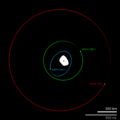130 Elektra facts for kids
130 Elektra is a very large asteroid found in the main asteroid belt. This is a busy area between Mars and Jupiter where many asteroids orbit the Sun.
A scientist named C. H. F. Peters discovered Elektra on February 17, 1873. He named it after Elektra, a character from Greek mythology.
Elektra is a G-type asteroid. This means it is likely made of similar materials to Ceres, which is a dwarf planet. Scientists have even found signs of organic compounds on its surface. These are the building blocks of life!
Scientists have used special telescopes to study Elektra. They found that it is not perfectly round. Its surface also has areas that reflect different amounts of light. This is called albedo.
Contents
Elektra's Moon: S/2003 (130) 1
In 2003, scientists found a small moon orbiting Elektra. They used the powerful Keck II telescope to spot it.
This moon is about 4 km wide. It orbits Elektra at a distance of about 1170 km. The moon's official name is S/2003 (130) 1. Because it has only been seen a few times, its exact path around Elektra is still being studied.
| Discovery | |
|---|---|
| Discovered by | W. J. Merline, P. M. Tamblyn, C. Dumas, L. M. Close, C. R. Chapman, and F. Menard |
| Discovery date | 15 August, 2003 |
| Designations | |
| Main belt | |
| Orbital characteristics | |
| 1252 ± 30 km | |
| Eccentricity | unknown, likely small |
| 3.92 ± 0.03 d | |
|
Average orbital speed
|
23 m/s |
| Inclination | uncertain |
| Satellite of | 130 Elektra |
| Physical characteristics | |
| Dimensions | 6 ± 2 km |
| Mass | ~4×1014 kg |
|
Equatorial escape velocity
|
~ 4 m/s |
| 14.5 | |
Elektra's Second Moon: S/2014 (130) 1
In 2014, scientists made another exciting discovery! They found a second moon orbiting Elektra. This makes Elektra one of the very few asteroids known to have more than one moon.
The second moon is called S/2014 (130) 1. It is smaller than the first moon and orbits Elektra even closer. This discovery helps scientists learn more about how asteroids and their moons form and move in space.
| Discovery | |||||||||||||
|---|---|---|---|---|---|---|---|---|---|---|---|---|---|
| Discovered by | Christian Heinrich Friedrich Peters | ||||||||||||
| Discovery date | February 17, 1873 | ||||||||||||
| Designations | |||||||||||||
| Main belt | |||||||||||||
| Orbital characteristics | |||||||||||||
| Epoch December 31, 2006 (JD 2454100.5) | |||||||||||||
| Aphelion | 565.778 Gm (3.782 AU) | ||||||||||||
| Perihelion | 369.263 Gm (2.468 AU) | ||||||||||||
| 467.521 G m (3.125 AU) | |||||||||||||
| Eccentricity | 0.210 | ||||||||||||
| 2017.954 d (5.52 a) | |||||||||||||
|
Average orbital speed
|
16.66 km/s | ||||||||||||
| 225.604° | |||||||||||||
| Inclination | 22.838° | ||||||||||||
| 145.635° | |||||||||||||
| 234.753° | |||||||||||||
| Known satellites | S/2003 (130) 1 | ||||||||||||
| Physical characteristics | |||||||||||||
| Dimensions | 215×155 ± 12 km | ||||||||||||
| Mass | 1.28±0.10×1019 kg | ||||||||||||
|
Mean density
|
3.8 ± 0.3 g/cm³ | ||||||||||||
|
Equatorial surface gravity
|
0.07 m/s² | ||||||||||||
|
Equatorial escape velocity
|
0.13 km/s | ||||||||||||
|
Sidereal rotation period
|
0.230103 d (5.52247 h) | ||||||||||||
| 157° | |||||||||||||
|
Pole ecliptic latitude
|
-88° | ||||||||||||
|
Pole ecliptic longitude
|
68° | ||||||||||||
| 0.076 ± 0.011 | |||||||||||||
|
|||||||||||||
| G | |||||||||||||
| 7.12 | |||||||||||||
Studying Elektra
Scientists continue to study Elektra and its moons. By watching how the moons orbit, they can figure out Elektra's mass more accurately. This helps them understand what Elektra is made of and how dense it is.
Elektra's density is quite high for an asteroid. This suggests it might have a different makeup than some other space rocks.
- 130 Elektra and S/2003 (130) 1, orbit data website maintained by F. Marchis. Includes adaptive optics image of primary, and satellite orbit diagram.
Images for kids
See also
 In Spanish: (130) Elektra para niños
In Spanish: (130) Elektra para niños



